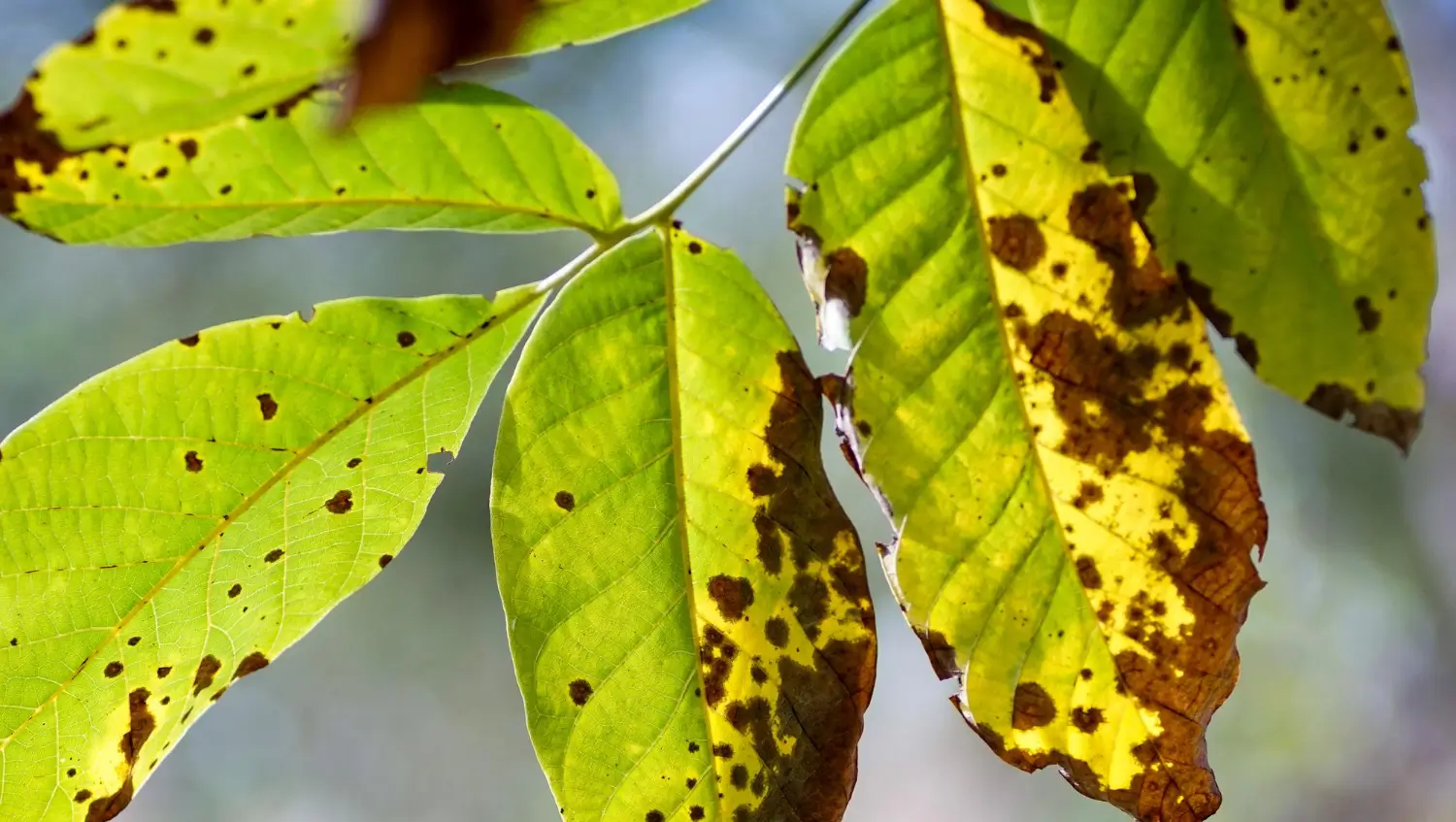
August 24, 2025

Healthy crops play a key role in agriculture by providing food, supporting the economy, and protecting the environment. Farmers worldwide depend on successful harvests to nourish people and sustain their livelihoods. However, keeping crops healthy is difficult due to pests and diseases, with fungal infections being one of the biggest threats.
Fungal diseases can seriously harm crop production by slowing plant growth, reducing yields, and sometimes destroying entire fields. These diseases spread quickly through spores, especially in warm and humid weather. The financial impact of fungal diseases is severe. Farmers may lose income due to lower crop yields, higher spending on fungicides, and decreased market value of infected crops.
Fungal diseases harm the environment and cause financial losses. Excessive use of chemical fungicides to control infections can damage soil, pollute water sources, and make fungi more resistant to treatment. Growcycle provides various products, such as NATRIA® Disease & Fungus Control, a ready-to-use solution suitable for organic gardening. It is designed to treat a wide range of fungal diseases on fruits, vegetables, and flowers.
Fungal diseases in crops are caused by microscopic organisms called fungi, which survive in soil, water, air, and plant debris. These pathogens reproduce through tiny spores that spread easily via wind, water, insects, and contaminated tools. Once spores land on a plant, they germinate and penetrate tissues, feeding on plant cells and disrupting normal growth.
Fungi thrive in warm, moist environments, making humid conditions ideal for their development. Some fungi attack leaves, stems, and flowers, while others target roots, causing decay and reduced nutrient uptake. Because fungi multiply quickly, early detection and prevention are crucial to stopping their spread.
Several fungal diseases affect different types of plants worldwide. Some of the most common include:
Several factors, including environmental conditions, poor agricultural practices, and improper soil and water management, influence plant fungal diseases. These factors create a favorable environment for fungi to grow and spread, leading to severe crop damage if not properly controlled.
Most fungal diseases develop in damp conditions. Excess moisture from rainfall, irrigation, or morning dew provides the perfect environment for fungal spores to germinate and infect plants. Dense foliage and poor air circulation further increase humidity levels, encouraging fungal growth.
Sudden temperature changes can weaken plant defenses, making them more vulnerable to fungal infections. Warm temperatures often fasten fungal growth, while cooler temperatures and moisture can promote diseases like downy mildew and blight.
When plants are spaced too closely together, air circulation is restricted, creating a humid microclimate where fungi thrive. Dense planting also makes spreading diseases from one plant to another easier.
Excessive nitrogen fertilizer promotes rapid, soft growth, which is more susceptible to fungal infections. Additionally, overusing pesticides can kill beneficial microorganisms that naturally control fungal pathogens, leading to an imbalance in the ecosystem.
Waterlogged soil creates an oxygen-deficient environment that weakens plant roots and encourages the growth of root-rotting fungi like Fusarium and Phytophthora. Fields with compacted or clay-heavy soil are particularly at risk.
Using water from infected sources can introduce fungal spores to crops. If irrigation water is not properly managed, diseases like Fusarium wilt and Pythium root rot can spread across large areas.
Preventing fungal diseases is more effective and sustainable than treating them after infection. Adopting different strategies like resistant crop varieties, proper farming techniques, and biological controls can help minimize the risk of fungal outbreaks.
Many crops have disease-resistant varieties developed through traditional breeding or modern biotechnology. These varieties can naturally withstand fungal attacks, reducing the need for chemical treatments. Farmers should select seeds that are suited to their local climate and resistant to common fungal diseases in their region.
Genetic engineering advances have enabled crop development with efficient resistance to fungal pathogens. Certain wheat and rice varieties are engineered to resist rust and blight. Natural resistance mechanisms, such as thick cell walls and antifungal compounds, also help plants defend against infections.
Growing the same crop in the same field year after year allows fungi to accumulate in the soil. Rotating crops with non-host plants disrupts their ability to survive and spread. For example, alternating cereals with legumes or root vegetables can help reduce fungal infections.
Growing different plant species together improves biodiversity and reduces disease pressure. Some plants, such as garlic and marigolds, produce natural antifungal compounds that protect neighboring crops. Increased plant diversity also attracts beneficial insects and microorganisms that help suppress fungal pathogens.
Healthy soil and proper irrigation methods can create an environment that discourages fungal growth. Adding compost, mulch, and organic fertilizers improves soil structure and microbial diversity, which helps suppress harmful fungi. Well-drained, nutrient-rich soil promotes strong plant growth, making crops more resistant to diseases.
Overhead watering can create prolonged leaf wetness, increasing the risk of fungal infections. Drip irrigation delivers water directly to the roots, minimizing excess moisture on plant surfaces. This method conserves water and reduces the spread of foliar diseases like mildew and blight.
Proper plant spacing and air movement help reduce humidity levels and prevent fungal spores from settling.
Removing excess leaves and branches improves air circulation and light penetration, creating unfavorable conditions for fungal growth. Proper spacing between plants prevents overcrowding and reduces the spread of infections.
Proper ventilation through fans or vents reduces humidity and prevents fungal buildup in greenhouse farming. In open fields, windbreaks and strategic planting arrangements help regulate airflow and reduce moisture accumulation.
Biological control methods use natural organisms and plant-based solutions to fight fungal diseases.
Despite the best prevention efforts, fungal diseases can still occur and spread quickly if not managed properly. Effective treatment strategies include the use of chemical and organic fungicides, integrated pest management (IPM), and emergency actions for severe infections. Understanding when and how to apply these treatments can help minimize crop losses while maintaining sustainable farming practices.
Chemical fungicides are widely used to control fungal diseases, but they must be applied correctly to be effective and safe. Fungicides are classified into two main types:
To maximize effectiveness, fungicides should be applied under the right conditions:
For farmers looking for sustainable alternatives, organic and natural fungicides offer effective solutions with minimal environmental impact.
An Integrated Pest Management (IPM) approach combines multiple strategies to control fungal diseases effectively while minimizing environmental impact. IPM involves using a mix of control measures:
Regular field inspections help detect fungal infections early, allowing for timely interventions. Farmers can use weather forecasts, disease models, and plant health monitoring tools to predict outbreaks and take preventive action.
Severely infected plants should be removed and destroyed to stop the spread of spores. This is especially important for highly contagious diseases like late blight and rust. Avoid composting infected plant material, as some fungi can survive and reinfect future crops.
If an outbreak occurs, affected areas should be isolated to prevent the disease from spreading to healthy crops. Farmers should:
As fungal diseases continue to threaten global food production, new technological advancements and sustainable farming practices are emerging to improve disease prevention and control.
Scientists are developing genetically modified (GM) crops with built-in resistance to fungal pathogens. By introducing resistance genes from naturally disease-resistant plants, crops such as wheat, rice, and soybeans can better withstand infections like rust, blight, and mildew. These innovations help farmers reduce crop losses and dependency on fungicides.
CRISPR gene-editing technology allows precise modifications to plant DNA, enabling the development of disease-resistant crops without introducing foreign genes. Researchers use CRISPR to improve plant immunity, making crops more resilient against fungal attacks. This breakthrough has the potential to revolutionize disease management in agriculture.
Artificial intelligence (AI) and digital technologies are transforming how farmers detect and manage fungal diseases. Drones equipped with multispectral cameras and sensors can quickly scan large fields and identify early signs of fungal infections. By analyzing plant health data, farmers can take preventive measures before the disease spreads.
Machine learning algorithms analyze crop images to detect fungal infections at an early stage. Mobile apps and smart sensors help farmers diagnose diseases in real time and recommend treatment options, improving decision-making and reducing crop losses.
Farmers are adopting eco-friendly approaches that improve soil and plant resilience against fungal diseases to ensure long-term agricultural health. Regenerative agriculture restores soil health through crop diversity, cover cropping, and reduced tillage. Healthy soil supports beneficial microbes that naturally suppress fungal pathogens, reducing the need for chemical fungicides.
Integrating trees, shrubs, and diverse plant species into farming systems improves biodiversity and reduces disease pressure. Certain tree species release natural antifungal compounds, while mixed planting disrupts the life cycle of fungal pathogens.
What is the best treatment for fungal diseases?
The best treatment depends on the disease and crop. Systemic fungicides work well for severe infections, while organic options like neem oil and copper-based sprays are effective for mild cases.
How to overcome antifungal resistance?
To prevent resistance, fungicides with different active ingredients should be rotated, chemical treatments should be avoided, and cultural and biological disease management methods should be integrated.
What is the fastest home remedy for fungal infections?
Baking soda solution (1 tbsp per gallon of water) or neem oil spray can help suppress fungal growth quickly. Removing infected plant parts also helps contain the spread.
Prevention is the best way to manage fungal diseases. Strategies like choosing disease-resistant crop varieties, practicing crop rotation, and improving soil and water management are effective. Biological control methods and good sanitation also help prevent the spread of fungal infections. While chemical fungicides can be useful, they should be used carefully to avoid resistance and reduce environmental harm.
Farmers will have better tools to protect their crops as technology advances, leading to a more secure and sustainable agricultural future. Explore Growcycle to learn more about the best products available to control plant fungal diseases.
Disclaimer: This material is for informational purposes only and should not be relied on for legal, medical, financial, or any other form of professional advice.